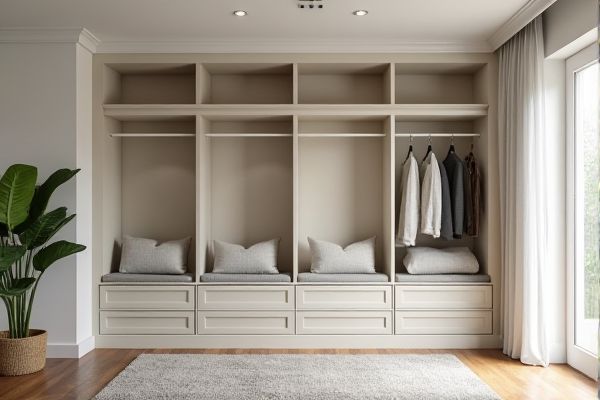
Built-in cubbies offer a seamless, permanent storage solution that maximizes space efficiency by integrating directly into your walls or furniture, while modular cubbies provide flexibility with customizable, movable units adaptable to various spaces and needs. Explore the rest of the article to determine which cubby option best suits your storage preferences and lifestyle.
Table of Comparison
| Feature | Built-in Cubbies | Modular Cubbies |
|---|---|---|
| Installation | Permanently fixed during construction or renovation | Easy to assemble, move, and reconfigure |
| Customization | Limited to design phase; permanent layout | Highly flexible; customizable in size and shape |
| Cost | Higher upfront cost due to construction | Generally lower cost; scalable investment |
| Durability | Typically more durable due to fixed installation | Varies; quality depends on materials used |
| Space Utilization | Optimized for the specific room layout | Flexible but may require extra floor space |
| Maintenance | Easy to clean; integrated design | Removable parts allow easy cleaning and repair |
| Resale Value | Can increase property value | Less impact on property value |
| Examples | Built-in wall cubbies, under-stair cubbies | Stackable cube storage, freestanding units |
Introduction to Built-in and Modular Cubbies
Built-in cubbies offer a seamless, space-saving storage solution that integrates directly into your existing walls, providing a permanent and sturdy option ideal for maximizing room efficiency. Modular cubbies, by contrast, are versatile and customizable units that can be rearranged or expanded to suit changing storage needs, making them perfect for flexible organization. Choosing between built-in and modular cubbies depends on your space constraints, budget, and whether you prefer a fixed or adaptable storage system.
Key Differences Between Built-in and Modular Cubbies
Built-in cubbies are permanently integrated into your space, offering a seamless and customized storage solution tailored to your room's dimensions and design. Modular cubbies provide flexibility, allowing you to rearrange or expand storage as needed, making them ideal for changing organizational needs. Choosing between built-in and modular cubbies depends on your preference for long-term customization versus adaptable functionality.
Pros and Cons of Built-in Cubbies
Built-in cubbies offer a seamless, space-saving storage solution that maximizes room efficiency and adds a custom, integrated look ideal for entryways and mudrooms. They provide durability and a cohesive design but can be costly to install and lack flexibility for reconfiguration or relocation. Maintenance and updates require professional work, making built-in cubbies less adaptable compared to modular alternatives.
Advantages and Drawbacks of Modular Cubbies
Modular cubbies offer flexibility and customization, allowing you to easily adjust storage configurations to fit changing needs or spaces. They are ideal for renters or those seeking temporary solutions, as they can be assembled, disassembled, and relocated without damage. However, modular cubbies may lack the seamless integration and durability of built-in options, sometimes resulting in less stability and lower aesthetic cohesion.
Space Efficiency Comparison
Built-in cubbies maximize space efficiency by seamlessly integrating with existing walls and structures, reducing wasted gaps and making use of vertical space effectively. Modular cubbies offer flexible configurations but may require extra room for assembly and adjustment, occasionally leading to less optimal use of available space. Overall, built-in designs typically provide a more streamlined, space-saving solution ideal for maximizing storage in compact areas.
Installation and Customization Options
Built-in cubbies require professional installation and are designed to fit seamlessly into specific spaces, offering a permanent storage solution tailored to exact dimensions and architectural features. Modular cubbies allow for easy self-installation and provide flexible customization through interchangeable units that can be rearranged or expanded according to changing storage needs. Both options cater to custom preferences, but built-in cubbies prioritize integration, while modular cubbies emphasize versatility and adaptability.
Durability and Maintenance Considerations
Built-in cubbies typically offer superior durability due to their fixed structure and integration with surrounding walls, reducing the risk of movement and wear over time. Maintenance is often simpler for built-in units as their materials and finishes are consistent with the home, allowing for straightforward cleaning and touch-ups. Modular cubbies, while flexible and easy to reconfigure, may require more frequent checks for loose connections and can suffer from wear on joints or connectors, increasing maintenance needs.
Cost Analysis: Built-in vs Modular Cubbies
Built-in cubbies generally require a higher upfront investment due to custom design, installation, and materials, often ranging from $500 to $1,500 per unit, whereas modular cubbies offer a more budget-friendly option with prices typically between $100 and $400 per unit. Maintenance and flexibility costs are lower with modular cubbies since they can be easily relocated or expanded without professional installation, reducing long-term expenses. For homeowners seeking cost efficiency and adaptability, modular cubbies present a scalable solution, while built-in cubbies add value through permanent integration and customized aesthetics that may increase property worth.
Best Use Cases for Each Type
Built-in cubbies excel in maximizing space in permanent, customized storage solutions ideal for entryways, mudrooms, and children's rooms where seamless integration with existing architecture is desired. Modular cubbies offer flexibility and adaptability, making them perfect for evolving organizational needs in offices, playrooms, or rental properties where mobility and reconfiguration are prioritized. Choosing between built-in and modular cubbies depends on factors such as permanence, customization level, and the need for future adaptability.
Choosing the Right Cubbies for Your Space
Built-in cubbies offer a seamless, custom fit that maximizes space efficiency and integrates perfectly with existing design elements, making them ideal for permanent storage solutions. Modular cubbies provide flexibility with adaptable configurations and easy relocation, perfect for dynamic spaces or evolving storage needs. Assessing your available area, storage requirements, and long-term usage will help determine whether the fixed elegance of built-in cubbies or the versatile convenience of modular options best suits your environment.
 homyna.com
homyna.com